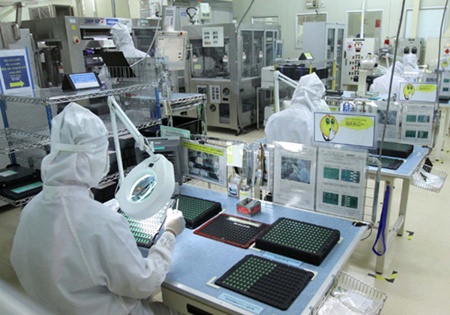
| Japanese SMEs keen on VN, expect better business climate | |
Many Japanese small and medium-sized enterprises (SMEs) find Viet Nam a prime destination for business in Southeast Asia due to the country’s stable political environment and vast economic potential. However, the business climate and investment policies needed to be improved in order to attract further Japanese investment, experts from the two countries said at a forum in Ha Noi last week. Import-export turnover between the two countries reached US$25.3 billion in 2013, nearly twice that of 2009, according to Viet Nam Customs. The two countries aim to double both trade turnover and investment flow by 2020. Viet Nam’s long-standing relationships with Japan and important position in ASEAN meant Japanese business could use the country to reach the ASEAN market and seek strategic partners in the region, Viet Nam-Japan Business Association (VJBA) Chairman Dinh Ngoc Hai said at the forum. He noted that Viet Nam had recently seen changes in Japanese investment, with a greater number of SMEs operating in services, information technology, human resources, agriculture and support industries. Since small- and medium-sized enterprises differed significantly from large corporations, there was a need for Vietnamese authorities to develop policies specifically for SMEs. A recent survey found that 70 per cent of Japanese companies planned to expand their business in Viet Nam and considered the country a prime destination for Japanese businesses. As of September, Japan had more than 2,400 projects in Viet Nam with total capital of US$36.3 billion, according to the Viet Nam Foreign Investment Agency. Major hurdles Representatives of Japanese SMEs said that Viet Nam’s state of economic development was similar to that of Japan many years ago, meaning that they saw opportunity for Japanese investment. However, while Viet Nam’s investment environment had improved significantly in recent years, experts said that poor infrastructure and support industries and a shortage of skilled labour continued to be major hurdles. Additionally, administrative procedures remained complicated as customs procedures, tariffs and preferential policies for enterprises were not consistent. Japanese business representative Seiji Satoh said that Japanese SMEs hoping to invest in Viet Nam often waited a long time for investment licences. In Japan, a company could use an investment licence obtained in one province to execute its investment in other provinces, but this was not the case in Viet Nam. Japanese companies said that to promote investment and co-operation from Japan, Viet Nam should hold forums to provide Japanese companies with necessary information and offer better investment conditions for Japanese SMEs. — VNS Former Viet Nam Ambassador in Japan Nguyen Phu Binh advocated further business co-operation between the two countries, as experience and technology from Japan could help Viet Nam develop its fledging support industries and improve product quality, thus enhancing product value. Japan was Viet Nam’s largest source of ODA from 1993-2013. Between 2011 and 2013, Japan topped the list of 101 countries and territories investing in Viet Nam. In 2012, Japanese investments accounted for half of the total foreign direct investment in the country. | |
| VIR |
